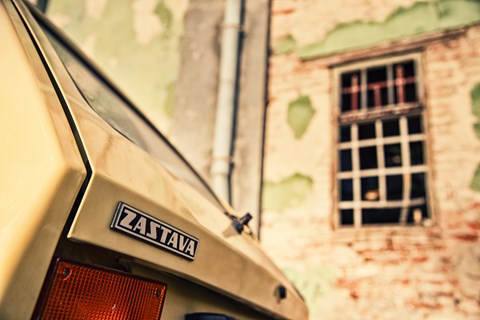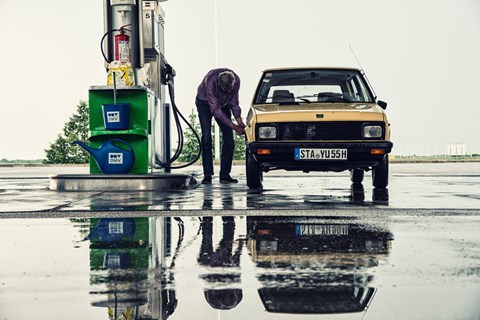► Driving a 35-year-old Yugo
► 800 miles in high summer…
► …with no A/C and a sickly engine
It’s 35 years since this car was built, in a country that no longer exists. At times on an 800-mile drive from Munich to the site of the factory where it was made in 1984, the Yugo 55 feels so alien and antiquated that it might as well be from another planet. But when you forget about its crudity and unreliability, you start to wonder if perhaps something precious has been lost in the demise of cars this light, simple and cheap.
Did I say cheap? If only. I bought this 55L from its first owner, a Serbian-born Belgian pensioner. I paid him €2000, and within a couple of weeks I’d had to pay a further €2850 in repairs, servicing, insurance and other legal necessities. It broke down the first time I drove it, after it had been trailered to me from Belgium. But the mechanic who helped me out, Yüksel Avcitürk, reminded me of what I’d found so appealing about buying this communist people’s car. ‘At last,’ he said, ‘a vehicle built for old-school mechanics like me, and not for computer nerds who charge you three figures simply for hooking up their laptop. Can’t wait to get on with it.’
After two hours, he got the engine to fire up. After four it was happy to idle, and ready to begin our 800-mile drive from Germany, across Austria and into Hungary, and then down into Serbia – which was part of communist Yugoslavia until civil war wiped that country off the map in 1992. In modern fast-lane high-tech big-bucks Germany the Yugo doesn’t make much sense. It’s small, light and slow, and other drivers act as if it’s not there, impatiently squeezing past, clearly unimpressed by the various shades of brown plastic, brown cloth and brown metal. But away from the autobahns, the reaction is very different. This frail-looking hatchback on skate-like 13-inch tyres got more thumbs-ups, more video selfies and more friendly cuffs on the roof than a McLaren P1 shrink-wrapped in gold. The Yugo gave every Eastern Bloc truck driver and every Serbian expat a shimmer of rose-tinted dèjá vu.

Initially, the top speed levelled off at an indicated 105km/h (65mph), tip-in was rough enough to throw the slowly mounting momentum off-kilter, the fuel gauge showed empty when the tank was full, wind noise tried to out-howl road noise, and the fuel consumption worked out at a Porsche-like 28mpg. But it was getting better by the mile. When Vienna’s landmark ferris wheel appeared on the horizon, maximum velocity climbed to 80mph, and since the respiratory tracts had cleansed themselves, the entire 59lb ft of pulling power was now on call.
Having said that, smoking was still out of the question due to the low-
octane fumes that filled the cabin, and it would take three complete cycles in the washing machine before our clothes stopped smelling of petrol.
Also, the battery warning light suddenly took centre stage, the loose wiring of the aftermarket radio sizzled the speakers to stubborn silence, the door mirror kept being flattened by the wind, and the backrest adjuster of the driver’s seat had seized in an excessively laid-back position. Everything else worked spot-on, though, absolutely spot-on.
Austrians love to go shopping in Hungary, where salami is half-price, a hairdo costs the same as a coffee back home, and dentists are so cheap you can have a complete overhaul for the price of a single filling in Austria. But this means a lot of eastbound traffic, and the Yugo started to overheat on the stop-start A1, and then became reluctant to restart. So to avoid embarrassment we fled the highway and let Google Maps guide us along bumpy but mostly arrow-straight B-roads last surfaced when the country was still a monarchy. With little more than 50bhp at your disposal, overtaking trucks is a leap into the unknown
 .
.
There was more overheating in a nerve-wracking three-hour tailback at the Serbian border. The Yugo’s such a featherweight that it was actually easier to get out and push the car a few yards at a time. When we eventually got across the heavily guarded border, the Yugo was universally recognised; later models are still an everyday sight here. Despite its justified reputation for breaking down at random or rotting in double-quick time, there’s a fondness for the Yugo. True, it’s not a quality piece of kit, but it oozes affability, simplicity and approachability. You can see why people got attached to them. Heading for the capital, Belgrade, the wipers were stretched to their limits by a monsoon, which also gave the new Uniroyal rain tyres a tough time. And the brakes. But by the end of a 10-hour day, no more than 20 cars had passed us; that said, we’d noticed about the same number of Yugos stranded on the hard shoulder, waiting for DIY talent, professional help or the last rites. The poorer the area you’re in, the more Yugos you see. There are precious few to be seen in big cities, but they still splutter in droves through rural areas, ranking above donkeys, pre-war tractors and scooters in the Serbian transport hierarchy.
Despite looking like they’d been rescued from a skip outside an old folks’ home, our seats were properly upholstered with horse hair and real springs for what turned out to be decent long-distance comfort. Even though aerodynamic efficiency was evidently not part of the design brief, the thin, upright roof pillars give good all-round visibility. Keep your eyes peeled in both directions, and the narrow-track lightweight displays an unexpected swiftness not unlike the original Mini.

Like that iconic Brit, there’s not much in the way of mod cons. Nothing is automatic, very little is adjustable, and the steering column doesn’t collapse in a collision. You also get unassisted steering, a reverse gear that generally won’t engage until the third attempt, a pushrod engine, fake fur cabin inlays and a filler cap lock that will drive you crazy. Character building…
As we arrived in Kragujevac it was 10.45pm and 25ºC. Like the car, we were feeling hot, exhausted and a little wounded. The Yugo was now stalling at every set of traffic lights, limping on two or three cylinders to our B&B near the Fiat factory that replaced the Yugo works.
The next morning, to no one’s surprise, the engine didn’t start. But the silver lining is that this introduced us to a local mechanic called Rocky and his many mates. The stout Serbian spannerman wrestled our Yugo like a long-lost son. Chewing consonants with an impatient mutter, he held one ear close to the engine while fumbling with greasy fingers on the carburettor until the idle speed dropped from 2000 to 750rpm. While he was at it, the fuel tank was sealed, the wiring fixed and the handbrake travel re-adjusted. In the meantime, his son had dashed to a nearby accessory store for an air filter and a distributor cap. As if lured by the charismatic pinking combustion noises, other Yugos (usually badged Zastava; Yugo was largely reserved for exports) started creeping our way, their owners marvelling at our car, praising the original paintjob, the ultra-rare L specification and the slickness of the notoriously baulky transmission.

That evening we were introduced to Slavo and his bespoilered one-off 600 convertible, Aleksandar in a barely street-legal stealth 120bhp 55, and Vladan at the wheel of a Zastava 600 on steroids with bordello-red velour upholstery and a roof trimmed in black leather. Before everyone started hitting the turps, the three Yugoista offered to give my 55 a thorough check-up the following morning at 8am sharp. When we told them that the original plan was to donate this piece of Serbian motor history to a local charity for auction, there was an awkward silence. ‘In Kragujevac we have more than enough Yugos, and even the best ones are worth almost nothing,’ said Slato Bataveljic, the chairman of the Zastava owners’ club. ‘I value your car at approximately €600. After all, it is still possible to buy brand new models for €4000 or less. In terms of street cred, a Yugo ranks right at the bottom. Everyone who can afford to drives an import.’
In under two hours, Aleksandar changed the timing belt, distributor finger, spark plugs, head gasket, oil and filter. The charge? Under €100 including parts. But bear in mind that Serbian wages are low – lower in the Fiat factory than they were in the Yugo plant. You get the impression the country has had more of a struggle to recover from the civil war than Croatia and Slovenia. The signs are all around: unfinished buildings in various states of decay, patchy infrastructure and a greying population, as so many young people seek a better life in Western Europe.

Slavo started working at Zastava in 1971, six years before the Yugo was launched. ‘From day one, extra TLC went into the cars earmarked for Europe and the US. While the Florida was too big for Yugoslavia and too rough for the rest of the world, the Yugo stood for basic affordable transportation at its best. The chassis and drivetrain were of course inspired by the Fiat 127. To keep the price down, we could not afford modern technologies such as ABS brakes or airbags, but to meet the tougher emission standards the engine was at a later stage modified by Porsche at considerable cost. In the Kragujevac factory, Zastava had plenty of excellent craftsmen at its disposal, and yet it was the handful of robots that kept throwing spanners in the works. What really did us in was corrosion.’
Unloved, unwanted and underrated in its home town, my Yugo headed back north to Germany, and is now in the care of photographer Tom Salt at his old-car nursing home somewhere near Hamburg. Even though the actual mileage may after all be closer to 113,000km than to the claimed 13,000 clicks, and despite full-throttle emissions that still make birds drop dead from the sky, the car once dismissed as the world’s worst is in fact enjoying a second life as a practical urban runabout that should cost very little to maintain.
Clearly, there are plenty of better cars available than this Eastern European oddball, but in the course of the pending paradigm shift from big engines to electrification, this light, compact and nimble underdog makes a weird kind of sense.
